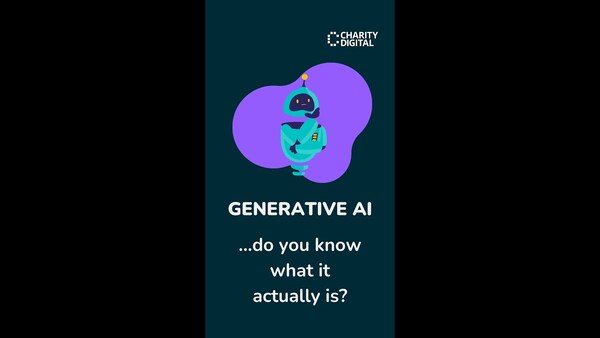Insights
INSIGHTS
All Topics
My Account
The environmental cost of generative A.I.
15 Dec 2023by Paul Rubens
We share what your charity needs to know to find a balance between the benefits of generative A.I. systems and the significant costs they impose on the environment
It’s a pretty safe bet that ChatGPT, or some other generative Artificial Intelligence (A.I.) system, could be hugely valuable to your charity. These systems allow you to produce content for your charity’s websites, as well as reports and other publications, very quickly, and at very low cost. The same technology can power cost-cutting chatbots, and it can be used for many other purposes besides.
But, inevitably, there are downsides to generative A.I., and one that appears to have been largely overlooked, at least until very recently, is the negative environmental impact that generative A.I. systems can have.
Put bluntly, generative A.I. can be terribly harmful to the environment. It’s important that charities understand this, particularly environmental charities or ones that are involved with any sort of green issues, or their actions risk undermining their message.
To understand why generative A.I. systems are so harmful to the environment, let’s take a closer look at the amount of energy that they inevitably consume.
Training these systems currently involves them examining over 500 billion words of text, resulting in the creation of about 300 tons of carbon dioxide (CO2), according to Harvard Business Review.
While this may not seem like a lot, research suggests that future versions which will be released every six months or so will likely result in orders of magnitude increases in CO2 emissions. So the problem may be small now but it is growing rapidly.
Far more significantly, actually using generative A.I. systems results in huge amounts of CO2 emissions. That’s because, while each individual query has relatively little impact on the environment, the number of queries made around the world each day can run in to the hundreds of millions, or perhaps billions.
Researchers at Nvidia, a company which makes processor chips for A.I. systems, estimate that replying to user queries accounts for 80 – 90% of the total energy used by generative A.I. systems during their lifetime.
Finally, it’s important to think about the millions of computer servers, running in cloud data centres, which run these generative A.I. systems. These servers require a huge amount of energy while they run (and a similar amount of energy is required to cool them.)
But this is dwarfed by the vast amount of energy required to manufacture them in the first place. Researchers from the Arizona State University and Rochester Institute of Technology found that 70% of the energy consumption of a typical computer is incurred during its manufacture.
Reducing the environmental impact of A.I.
So how can your charity take advantage of generative A.I. while minimising the impact on the environment? The good news is that there are plenty of steps you can take. Below, we’ve listed some of the most important ones.
Track your A.I. carbon footprint
Not all data centres are as carbon-efficient as each other. Some use renewable energy sources and ambient air for some of their cooling needs. Others user carbon-intensive energy sources, and rely on electricity-guzzling HVAC (heating, ventilation and cooling) systems to keep their servers at the right temperature.
That means that if you know where the generative A.I. systems that you use are operating, and how they are powered, you can get an understanding of their carbon footprint. That can help you decide whether switching to a different service could lower your carbon footprint significantly.
Include carbon emissions in your A.I. thinking
Before your charity adopts A.I. technology – with all the cost, speed, and other benefits that it brings – you need to think very hard about a number of things. These include the ethics of using A.I. with constituents’ confidential data, as well as the legal implications and any regulatory requirements to consider.
There is a very strong argument that the carbon footprint of A.I. usage should also be considered in this way. That’s to ensure that your charity can demonstrate that if it decides to use generative A.I., it has done so in a responsible way and that it has considered all the implications – including to the environment – of doing so.
Adapt what’s available already
If you work for a smaller charity its likely that you can use an existing generative A.I. system like ChatGPT by accessing it from the cloud. No energy needs to be expended on additional training.
Larger charities, however, may need something a little more tailored to their needs, including a system which is trained on the charities’ own data sets. If that’s the case then it is far more energy efficient to fine-tune an existing A.I. model than to create and train one from scratch.
Think about the value that an A.I. model provides
While fine tuning an existing A.I. model does require energy, it’s likely that the results from such a system will be more valuable. That, in itself, is an important consideration. Using an A.I. model inevitably requires energy consumption, and a responsible charity should always be asking whether its use of energy is justified.
If the results of a trained A.I. model are more valuable then it becomes easier to justify the energy usage that training and using it requires.
This type of thinking can help inform decisions about upgrades to generative A.I. systems too. If a “next generation” system uses twice the energy but is only marginally more useful than an existing system, then your charity might be wise to stick with what it already has.
Think about whether you need a generative A.I. at all
Your charity operated before the rise of generative A.I., so it’s fair to say that while the technology is useful, it is not essential. There are other ways of achieving whatever it is that you may be using the technology to do today.
If it is clear that you could be employing one of these alternative methods to get similar results without a significant cost to the environment (or your charity) then perhaps it is time to switch to one of these methods instead.
More on this topic
Recommended Products
Related Videos
Our Events
Charity Digital Academy
Our courses aim, in just three hours, to enhance soft skills and hard skills, boost your knowledge of finance and artificial intelligence, and supercharge your digital capabilities. Check out some of the incredible options by clicking here.






















